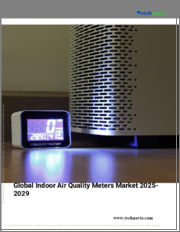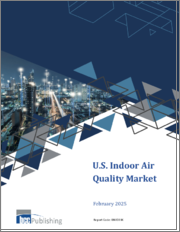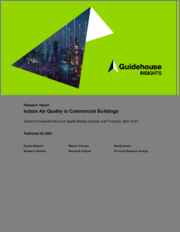
|
시장보고서
상품코드
1447063
전관 프레시 에어 시스템 시장 예측(-2030년) : 제품별, 유형별, 제어 유형별, 기술별, 용도별, 지역별 세계 분석Whole House Fresh Air System Market Forecasts to 2030 - Global Analysis By Product (Ventilation Fans, Air Purifiers and Air Exchangers), Type (Surface Mounted and Concealed Installation), Control Type, Technology, Application and By Geography |
||||||
Stratistics MRC에 따르면, 전 세계 전관 프레시 에어 시스템 시장은 예측 기간 동안 연평균 9.7%의 CAGR로 성장할 것으로 예상됩니다.
전관 프레시 에어 시스템은 집 전체에 걸쳐 실내의 정체된 공기를 신선한 외부 공기와 지속적으로 교환하여 실내 공기질을 개선하도록 설계된 환기 시스템입니다. 이 시스템은 오염물질과 알레르겐을 제거하는 고도의 여과를 채택하여 보다 건강한 주거 환경을 보장합니다. 환기, 습도 및 공기 순환을 조절하여 곰팡이, 냄새 및 오염 물질의 축적을 방지합니다. 전관 프레시 에어 시스템은 교환된 공기에서 열과 냉기를 회수하여 냉난방 시스템의 부담을 줄여 에너지 효율에 기여합니다.
스마트홈 통합
스마트홈 통합은 주택 소유주들이 편안함과 에너지 효율을 향상시킬 수 있는 자동화된 솔루션에 대한 수요가 증가함에 따라 중요한 원동력이 되고 있습니다. 이러한 시스템을 스마트홈 플랫폼과 통합하면 사용자는 실내 공기질, 환기 및 온도 설정을 원격으로 모니터링하고 제어할 수 있습니다. 이러한 수요는 원활한 통합을 통해 실내 환경 관리에 대한 보다 종합적이고 신속한 접근을 가능하게 하는 커넥티드 홈의 증가 추세에 힘입은 바 큽니다. 스마트홈 통합에 따른 편의성과 에너지 절감 효과가 시장을 견인하고 있습니다.
비용에 대한 고려
소비자나 기업이 이러한 시스템을 도입하는 경제적 타당성을 평가할 때 비용 고려는 매우 중요한 역할을 합니다. 장비 및 설치 비용을 포함한 초기 투자 비용은 구매 결정에 영향을 미칩니다. 운영 및 유지보수 비용은 장기적인 구매 가능성에 영향을 미치는 추가적인 요소입니다. 에너지 효율은 매우 중요한 측면으로, 운영 효율이 높을수록 유틸리티 비용이 낮아지는 경우가 많기 때문입니다. 또한, 정부의 인센티브와 리베이트의 가능성은 초기 비용을 줄여 전관 프레시 에어 시스템을 도입하는 것을 더욱 매력적으로 만듭니다.
건강에 대한 우려와 팬데믹에 대한 대비
전관 프레시 에어 시스템 시장은 건강 문제를 해결하고 팬데믹 대비를 강화하는 데 있어 큰 기회를 제공합니다. 이러한 시스템은 집 전체에 신선한 여과된 공기를 지속적으로 공급하여 실내 공기질에 기여하고 공기 중 오염 물질의 위험을 줄입니다. 건강에 대한 인식이 높아지고 팬데믹을 통해 얻은 교훈으로 인해 이러한 시스템에 대한 수요가 급증하고 있습니다. 전관 프레시 에어 시스템은 건강한 주거 환경을 제공할 뿐만 아니라 밀폐된 공간에서 감염성 물질의 확산을 최소화하는 중요한 역할을 하며, 종합적인 팬데믹 대응 전략의 중요한 구성요소로 자리매김하고 있습니다.
소비자 선호도 변화
소비자들이 실내 공기의 질과 건강을 점점 더 중요하게 생각함에 따라, 전관 프레시 에어 시스템 시장에서 소비자 선호도 변화의 위협은 매우 심각합니다. 환경 문제에 대한 인식이 높아지고 에너지 효율이 높은 솔루션에 대한 욕구가 높아짐에 따라 소비자들은 환경 친화적이고 기술적으로 진보된 환기 시스템으로 전환할 가능성이 있습니다. 또한, 스마트 홈과의 통합과 사용자 친화적인 제어에 대한 선호도가 시장 역학에 영향을 미칠 수 있습니다. 제조업체는 혁신적이고 지속가능한 솔루션을 제공하기 위해 연구 개발에 투자하고 이러한 진화하는 선호도에 발맞춰야 합니다.
COVID-19의 영향:
COVID-19는 사람들이 실내 공기의 질을 우선순위에 두게 되면서 시장에 큰 영향을 미쳤습니다. 호흡기 미립자를 통한 바이러스 감염에 대한 인식이 높아지면서 공기 순환과 여과를 개선할 수 있는 환기 시스템에 대한 수요가 증가하고 있습니다. 소비자들은 보다 건강한 실내 환경을 조성하고 공기 중 오염물질의 위험을 줄이기 위해 이러한 시스템에 대한 투자를 늘리고 있습니다. 호흡기 건강과 복지에 대한 관심이 높아지면서 첨단 공기 정화 기술의 채택이 가속화되어 시장 성장을 촉진하고 있습니다.
예측 기간 동안 공기청정기 분야가 가장 큰 비중을 차지할 것으로 예상
실내 공기질에 대한 인식이 높아짐에 따라 실내 공기청정기 시장은 공기청정기 분야에서 큰 폭으로 성장하고 있습니다. 소비자들은 건강한 생활 환경을 유지하는 것이 중요하다는 것을 인식하게 되면서 실내 환기 시스템에 통합된 공기청정기에 대한 수요가 급증하고 있으며, COVID-19 사태로 인해 공기 중 오염 물질에 대한 우려가 커지면서 공기 청정 솔루션의 채택이 더욱 가속화되고 있습니다. 또한, 스마트하고 에너지 효율적인 공기청정기와 같은 기술 발전은 사용자에게 가정 내 깨끗하고 신선한 공기를 보장하는 편리하고 효과적인 방법을 제공하여 이 부문의 성장에 기여하고 있습니다.
스마트 제어 시스템 분야는 예측 기간 동안 가장 높은 CAGR을 기록할 것으로 예상
스마트 제어 시스템 분야는 주택 환기 분야의 첨단 자동화 솔루션에 대한 수요 증가로 인해 큰 성장세를 보이고 있습니다. 소비자들은 공기질을 효율적으로 관리하고, 에너지 소비를 모니터링하고, 환기 설정을 원격으로 맞춤화할 수 있는 스마트 제어 기능을 선택하고 있습니다. 이러한 성장의 원동력은 IoT 기술과 홈 오토메이션의 통합으로, 사용자는 실시간 데이터를 얻고 실내 공기질을 제어할 수 있게 되었습니다. 또한 건강과 환경에 대한 인식이 높아짐에 따라 스마트 제어 시스템의 채택은 계속 확대될 것으로 예상됩니다.
가장 큰 점유율을 차지하는 지역:
북미의 전관 프레시 에어 시스템 시장은 실내 공기질에 대한 인식이 높아지고 건강과 웰빙에 대한 관심이 높아짐에 따라 최근 몇 년 동안 강력한 성장세를 보이고 있습니다. 소비자들이 전반적인 생활 환경을 개선할 수 있는 방법을 모색하면서 에너지 효율이 높은 통합 환기 솔루션에 대한 수요가 급증하고 있습니다. 환기 기준 개선을 위한 엄격한 규제와 건축법 개정으로 시장 확대에 더욱 박차를 가하고 있습니다. 또한, 이 지역의 지속적인 경제 발전과 지속가능한 생활 방식에 대한 선호는 북미 시장의 성장을 지속적으로 촉진할 것으로 예상됩니다.
CAGR이 가장 높은 지역:
아시아태평양은 실내 공기질에 대한 인식 증가, 도시화, 건강 및 웰빙에 대한 관심 증가 등의 요인으로 인해 괄목할 만한 성장세를 보이고 있습니다. 산업화와 급속한 도시 개발로 인해 오염도가 높아지면서 효율적인 공기 정화 솔루션에 대한 수요가 급증하고 있습니다. 지속가능한 삶을 추구하는 정부의 노력과 실내 공기질에 대한 엄격한 규제는 주거용 및 상업용 건물에서 전관 프레시 에어 시스템 채택을 더욱 촉진하고 있습니다. 이 지역의 중산층이 급증하고 환경 지속가능성에 대한 관심이 높아지면서 소비자들이 더 건강한 주거 환경을 우선시하게 되면서 시장 성장에 기여하고 있습니다.
무료 맞춤형 서비스:
이 보고서를 구독하는 고객은 다음과 같은 무료 맞춤화 옵션 중 하나를 사용할 수 있습니다:
- 기업 개요
- 추가 시장 기업의 종합적인 프로파일링(최대 3개사까지)
- 주요 기업 SWOT 분석(최대 3개사)
- 지역 세분화
- 고객의 관심에 따른 주요 국가별 시장 추정치, 예측, CAGR(주: 타당성 검토에 따른)
- 경쟁사 벤치마킹
- 제품 포트폴리오, 지리적 입지, 전략적 제휴를 기반으로 한 주요 기업 벤치마킹
목차
제1장 주요 요약
제2장 서문
- 개요
- 이해관계자
- 조사 범위
- 조사 방법
- 데이터 마이닝
- 데이터 분석
- 데이터 검증
- 조사 접근법
- 조사 소스
- 1차 조사 소스
- 2차 조사 소스
- 가정
제3장 시장 동향 분석
- 성장 촉진요인
- 성장 억제요인
- 기회
- 위협
- 제품 분석
- 기술 분석
- 용도 분석
- 신흥 시장
- 신종 코로나바이러스 감염증(COVID-19)의 영향
제4장 Porter's Five Forces 분석
- 공급 기업의 교섭력
- 구매자의 교섭력
- 대체품의 위협
- 신규 참여업체의 위협
- 경쟁 기업 간의 경쟁 관계
제5장 세계의 전관 프레시 에어 시스템 시장 : 제품별
- 환기팬
- 공기청정기
- 공기교환기
제6장 세계의 전관 프레시 에어 시스템 시장 : 유형별
- 표면 설치
- 은폐 설치
제7장 세계의 전관 프레시 에어 시스템 시장 : 제어 유형별
- 스마트 제어 시스템
- 수동 제어 시스템
제8장 세계의 전관 프레시 에어 시스템 시장 : 기술별
- 열 회수 환기(HRV)
- 에너지 회수 환기(ERV)
제9장 세계의 전관 프레시 에어 시스템 시장 : 용도별
- 가정
- 산업
- 상업
- 기타 용도
제10장 세계의 전관 프레시 에어 시스템 시장 : 지역별
- 북미
- 미국
- 캐나다
- 멕시코
- 유럽
- 독일
- 영국
- 이탈리아
- 프랑스
- 스페인
- 기타 유럽
- 아시아태평양
- 일본
- 중국
- 인도
- 호주
- 뉴질랜드
- 한국
- 기타 아시아태평양
- 남미
- 아르헨티나
- 브라질
- 칠레
- 기타 남미
- 중동 및 아프리카
- 사우디아라비아
- 아랍에미리트
- 카타르
- 남아프리카공화국
- 기타 중동 및 아프리카
제11장 주요 발전
- 계약, 파트너십, 협업, 합작투자
- 인수와 합병
- 신제품 발매
- 사업 확대
- 기타 주요 전략
제12장 기업 개요
- Aldes
- Broad Group
- Broan-NuTone
- Carrier
- Daikin Industries
- Honeywell
- Johnson Controls
- Lennox International
- LG Electronics
- Mitsubishi Electric
- Nortek Air Solutions
- Ostberg
- Panasonic
- Stulz GmbH
- Trane
- Zehnder Group
According to Stratistics MRC, the Global Whole House Fresh Air System Market is growing at a CAGR of 9.7% during the forecast period. A Whole House Fresh Air System is a ventilation system designed to improve indoor air quality by continuously exchanging stale indoor air with fresh outdoor air throughout an entire home. This system employs advanced filtration to remove pollutants and allergens, ensuring a healthier living environment. By regulating ventilation, humidity, and air circulation, it helps prevent the buildup of mold, odors, and contaminants. Whole-house fresh air systems contribute to energy efficiency by recovering heat or coolness from the exchanged air, reducing the strain on heating and cooling systems.
Market Dynamics:
Driver:
Smart home integration
Smart Home Integration is a key driver as homeowners increasingly seek automated solutions for enhanced comfort and energy efficiency. Integrating these systems with smart home platforms allows users to remotely monitor and control indoor air quality, ventilation, and temperature settings. The demand is fueled by the growing trend of connected homes, where seamless integration enables a more holistic and responsive approach to indoor environmental management. The convenience and energy-saving benefits associated with smart home integration are propelling the market.
Restraint:
Cost considerations
Cost considerations play a pivotal role as consumers and businesses evaluate the economic feasibility of adopting such systems. Initial investment costs, including equipment and installation expenses, influence purchasing decisions. Operational and maintenance costs are additional factors affecting long-term affordability. Energy efficiency is a crucial aspect, as higher operational efficiency often translates to lower utility bills. Moreover, the potential for government incentives or rebates can alleviate upfront expenses, making the adoption of Whole House Fresh Air Systems more attractive.
Opportunity:
Health concerns and pandemic preparedness
The Whole House Fresh Air System market presents a significant opportunity for addressing health concerns and enhancing pandemic preparedness. These systems contribute to indoor air quality by continuously supplying fresh and filtered air throughout the entire home, reducing the risk of airborne contaminants. Amidst growing health consciousness and the lessons learned from pandemics, the demand for such systems has surged. Whole-house fresh air systems not only provide a healthier living environment but also play a crucial role in minimizing the spread of infectious agents within enclosed spaces, positioning them as a vital component of comprehensive pandemic preparedness strategies.
Threat:
Changing consumer preferences
The threat of changing consumer preferences in the Whole House Fresh Air System market is significant as consumers increasingly prioritize indoor air quality and health. With a growing awareness of environmental concerns and a desire for energy-efficient solutions, consumers may shift towards eco-friendly and technologically advanced ventilation systems. Additionally, preferences for smart home integration and user-friendly controls can impact market dynamics. Manufacturers must stay attuned to these evolving preferences, investing in research and development to offer innovative, sustainable solutions.
Covid-19 Impact:
The COVID-19 pandemic has significantly impacted the market as people prioritize indoor air quality. With heightened awareness of virus transmission through respiratory particles, there is a growing demand for ventilation systems that can improve air circulation and filtration. Consumers are increasingly investing in these systems to create healthier indoor environments, reducing the risk of airborne contaminants. The emphasis on respiratory health and well-being has accelerated the adoption of advanced air purification technologies, boosting the market's growth.
The air purifiers segment is expected to be the largest during the forecast period
The Whole House Fresh Air System market has witnessed substantial growth in the Air Purifiers segment due to increasing awareness about indoor air quality. Consumers are increasingly recognizing the importance of maintaining a healthy living environment, leading to a surge in demand for air purifiers integrated into whole-house ventilation systems. The COVID-19 pandemic has also heightened concerns about airborne contaminants, further driving the adoption of air purification solutions. Additionally, technological advancements, such as smart and energy-efficient air purifiers, have contributed to the segment's growth, providing users with convenient and effective ways to ensure clean and fresh air throughout their homes.
The smart control systems segment is expected to have the highest CAGR during the forecast period
The Smart Control Systems segment has experienced significant growth due to the increasing demand for advanced and automated solutions in residential ventilation. Consumers are increasingly opting for smart control features that allow them to manage air quality efficiently, monitor energy consumption, and customize ventilation settings remotely. This growth is driven by the integration of IoT technologies and home automation, which provides users with real-time data and control over their indoor air quality. Furthermore, as awareness of health and environmental concerns rises, the adoption of smart control systems is expected to continue growing.
Region with largest share:
The Whole House Fresh Air System market in North America has experienced robust growth in recent years, driven by an increasing awareness of indoor air quality and a growing emphasis on health and well-being. The demand for energy-efficient and integrated ventilation solutions has surged as consumers seek ways to enhance overall living conditions. Stringent regulations and building codes advocating for improved ventilation standards have further fueled market expansion. Additionally, the region's sustained economic development and a preference for sustainable living practices are expected to continue driving growth in the market in North America.
Region with highest CAGR:
The Asia Pacific region has experienced significant growth, driven by factors such as rising awareness of indoor air quality, urbanization, and a growing focus on health and wellness. Increasing industrialization and rapid urban development have led to higher pollution levels, prompting a surge in demand for efficient air purification solutions. Government initiatives promoting sustainable living and stringent regulations on indoor air quality have further fueled the adoption of Whole House Fresh Air Systems in residential and commercial buildings. The region's burgeoning middle class, coupled with a heightened emphasis on environmental sustainability, has contributed to the robust expansion of the market as consumers prioritize healthier living environments.
Key players in the market
Some of the key players in Whole House Fresh Air System market include Aldes, Broad Group, Broan-NuTone, Carrier, Daikin Industries, Honeywell, Johnson Controls, Lennox International, LG Electronics , Mitsubishi Electric, Nortek Air Solutions, Ostberg , Panasonic, Stulz GmbH, Trane and Zehnder Group.
Key Developments:
In February 2024, Panasonic has acquired a 40% stake in Italian air conditioning and heat pump manufacturer Innova, as part of a business alliance agreement. The capital and business alliance will enable the two companies to collaborate in areas such as production and sales, with a focus on technological development in the residential hot water supply, air conditioning, and ventilation businesses.
In October 2023, Carrier, the global leader in air conditioning and refrigeration solutions, is set to make a significant investment in India. David Gitlin, Chairman & CEO of Carrier, stated that they plan to invest another $800 million in India over the next five years. One of the key drivers behind this investment is the enormous opportunity presented by India's low air-conditioning penetration.
Products Covered:
- Ventilation Fans
- Air Purifiers
- Air Exchangers
Types Covered:
- Surface Mounted
- Concealed Installation
Control Types Covered:
- Smart Control Systems
- Manual Control Systems
Technologies Covered:
- Heat Recovery Ventilation (HRV)
- Energy Recovery Ventilation (ERV)
Applications Covered:
- Household
- Industrial
- Commercial
- Other Applications
Regions Covered:
- North America
- US
- Canada
- Mexico
- Europe
- Germany
- UK
- Italy
- France
- Spain
- Rest of Europe
- Asia Pacific
- Japan
- China
- India
- Australia
- New Zealand
- South Korea
- Rest of Asia Pacific
- South America
- Argentina
- Brazil
- Chile
- Rest of South America
- Middle East & Africa
- Saudi Arabia
- UAE
- Qatar
- South Africa
- Rest of Middle East & Africa
What our report offers:
- Market share assessments for the regional and country-level segments
- Strategic recommendations for the new entrants
- Covers Market data for the years 2021, 2022, 2023, 2026, and 2030
- Market Trends (Drivers, Constraints, Opportunities, Threats, Challenges, Investment Opportunities, and recommendations)
- Strategic recommendations in key business segments based on the market estimations
- Competitive landscaping mapping the key common trends
- Company profiling with detailed strategies, financials, and recent developments
- Supply chain trends mapping the latest technological advancements
Free Customization Offerings:
All the customers of this report will be entitled to receive one of the following free customization options:
- Company Profiling
- Comprehensive profiling of additional market players (up to 3)
- SWOT Analysis of key players (up to 3)
- Regional Segmentation
- Market estimations, Forecasts and CAGR of any prominent country as per the client's interest (Note: Depends on feasibility check)
- Competitive Benchmarking
- Benchmarking of key players based on product portfolio, geographical presence, and strategic alliances
Table of Contents
1 Executive Summary
2 Preface
- 2.1 Abstract
- 2.2 Stake Holders
- 2.3 Research Scope
- 2.4 Research Methodology
- 2.4.1 Data Mining
- 2.4.2 Data Analysis
- 2.4.3 Data Validation
- 2.4.4 Research Approach
- 2.5 Research Sources
- 2.5.1 Primary Research Sources
- 2.5.2 Secondary Research Sources
- 2.5.3 Assumptions
3 Market Trend Analysis
- 3.1 Introduction
- 3.2 Drivers
- 3.3 Restraints
- 3.4 Opportunities
- 3.5 Threats
- 3.6 Product Analysis
- 3.7 Technology Analysis
- 3.8 Application Analysis
- 3.9 Emerging Markets
- 3.10 Impact of Covid-19
4 Porters Five Force Analysis
- 4.1 Bargaining power of suppliers
- 4.2 Bargaining power of buyers
- 4.3 Threat of substitutes
- 4.4 Threat of new entrants
- 4.5 Competitive rivalry
5 Global Whole House Fresh Air System Market, By Product
- 5.1 Introduction
- 5.2 Ventilation Fans
- 5.3 Air Purifiers
- 5.4 Air Exchangers
6 Global Whole House Fresh Air System Market, By Type
- 6.1 Introduction
- 6.2 Surface Mounted
- 6.3 Concealed Installation
7 Global Whole House Fresh Air System Market, By Control Type
- 7.1 Introduction
- 7.2 Smart Control Systems
- 7.3 Manual Control Systems
8 Global Whole House Fresh Air System Market, By Technology
- 8.1 Introduction
- 8.2 Heat Recovery Ventilation (HRV)
- 8.3 Energy Recovery Ventilation (ERV)
9 Global Whole House Fresh Air System Market, By Application
- 9.1 Introduction
- 9.2 Household
- 9.3 Industrial
- 9.4 Commercial
- 9.5 Other Applications
10 Global Whole House Fresh Air System Market, By Geography
- 10.1 Introduction
- 10.2 North America
- 10.2.1 US
- 10.2.2 Canada
- 10.2.3 Mexico
- 10.3 Europe
- 10.3.1 Germany
- 10.3.2 UK
- 10.3.3 Italy
- 10.3.4 France
- 10.3.5 Spain
- 10.3.6 Rest of Europe
- 10.4 Asia Pacific
- 10.4.1 Japan
- 10.4.2 China
- 10.4.3 India
- 10.4.4 Australia
- 10.4.5 New Zealand
- 10.4.6 South Korea
- 10.4.7 Rest of Asia Pacific
- 10.5 South America
- 10.5.1 Argentina
- 10.5.2 Brazil
- 10.5.3 Chile
- 10.5.4 Rest of South America
- 10.6 Middle East & Africa
- 10.6.1 Saudi Arabia
- 10.6.2 UAE
- 10.6.3 Qatar
- 10.6.4 South Africa
- 10.6.5 Rest of Middle East & Africa
11 Key Developments
- 11.1 Agreements, Partnerships, Collaborations and Joint Ventures
- 11.2 Acquisitions & Mergers
- 11.3 New Product Launch
- 11.4 Expansions
- 11.5 Other Key Strategies
12 Company Profiling
- 12.1 Aldes
- 12.2 Broad Group
- 12.3 Broan-NuTone
- 12.4 Carrier
- 12.5 Daikin Industries
- 12.6 Honeywell
- 12.7 Johnson Controls
- 12.8 Lennox International
- 12.9 LG Electronics
- 12.10 Mitsubishi Electric
- 12.11 Nortek Air Solutions
- 12.12 Ostberg
- 12.13 Panasonic
- 12.14 Stulz GmbH
- 12.15 Trane
- 12.16 Zehnder Group



















